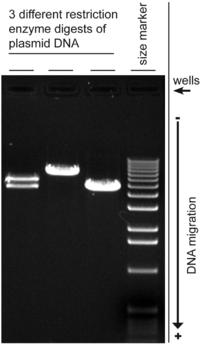
Photo from wikipedia
AbstractMiniaturized synthesis of positron emission tomography (PET) tracers is poised to offer numerous advantages including reduced tracer production costs and increased availability of diverse tracers. While many steps of the… Click to show full abstract
AbstractMiniaturized synthesis of positron emission tomography (PET) tracers is poised to offer numerous advantages including reduced tracer production costs and increased availability of diverse tracers. While many steps of the tracer production process have been miniaturized, there has been relatively little development of microscale systems for the quality control (QC) testing process that is required by regulatory agencies to ensure purity, identity, and biological safety of the radiotracer before use in human subjects. Every batch must be tested, and in contrast with ordinary pharmaceuticals, the whole set of tests of radiopharmaceuticals must be completed within a short-period of time to minimize losses due to radioactive decay. By replacing conventional techniques with microscale analytical ones, it may be possible to significantly reduce instrument cost, conserve lab space, shorten analysis times, and streamline this aspect of PET tracer production. We focus in this work on miniaturizing the subset of QC tests for chemical identity and purity. These tests generally require high-resolution chromatographic separation prior to detection to enable the approach to be applied to many different tracers (and their impurities), and have not yet, to the best of our knowledge, been tackled in microfluidic systems. Toward this end, we previously explored the feasibility of using the technique of capillary electrophoresis (CE) as a replacement for the “gold standard” approach of using high-performance liquid chromatography (HPLC) since CE offers similar separating power, flexibility, and sensitivity, but can readily be implemented in a microchip format. Using a conventional CE system, we previously demonstrated the successful separation of non-radioactive version of a clinical PET tracer, 3′-deoxy-3′-fluorothymidine (FLT), from its known by-products, and the separation of the PET tracer 1-(2′-deoxy-2′-fluoro-β-D-arabinofuranosyl)-cytosine (D-FAC) from its α-isomer, with sensitivity nearly as good as HPLC. Building on this feasibility study, in this paper, we describe the first effort to miniaturize the chemical identity and purity tests by using microchip electrophoresis (MCE). The fully automated proof-of-concept system comprises a chip for sample injection, a separation capillary, and an optical detection chip. Using the same model compound (FLT and its known by-products), we demonstrate that samples can be injected, separated, and detected, and show the potential to match the performance of HPLC. Addition of a radiation detector in the future would enable analysis of radiochemical identity and purity in the same device. We envision that eventually this MCE method could be combined with other miniaturized QC tests into a compact integrated system for automated routine QC testing of radiopharmaceuticals in the future. Graphical abstractMiniaturized quality control (QC) testing of batches of radiopharmaceuticals via microfluidic analysis. The proof-of-concept hybrid microchip electrophoresis (MCE) device demonstrated the feasibility of achieving comparable performance to conventional analytical instruments (HPLC or CE) for chemical purity testing.
Journal Title: Analytical and Bioanalytical Chemistry
Year Published: 2018
Link to full text (if available)
Share on Social Media: Sign Up to like & get
recommendations!